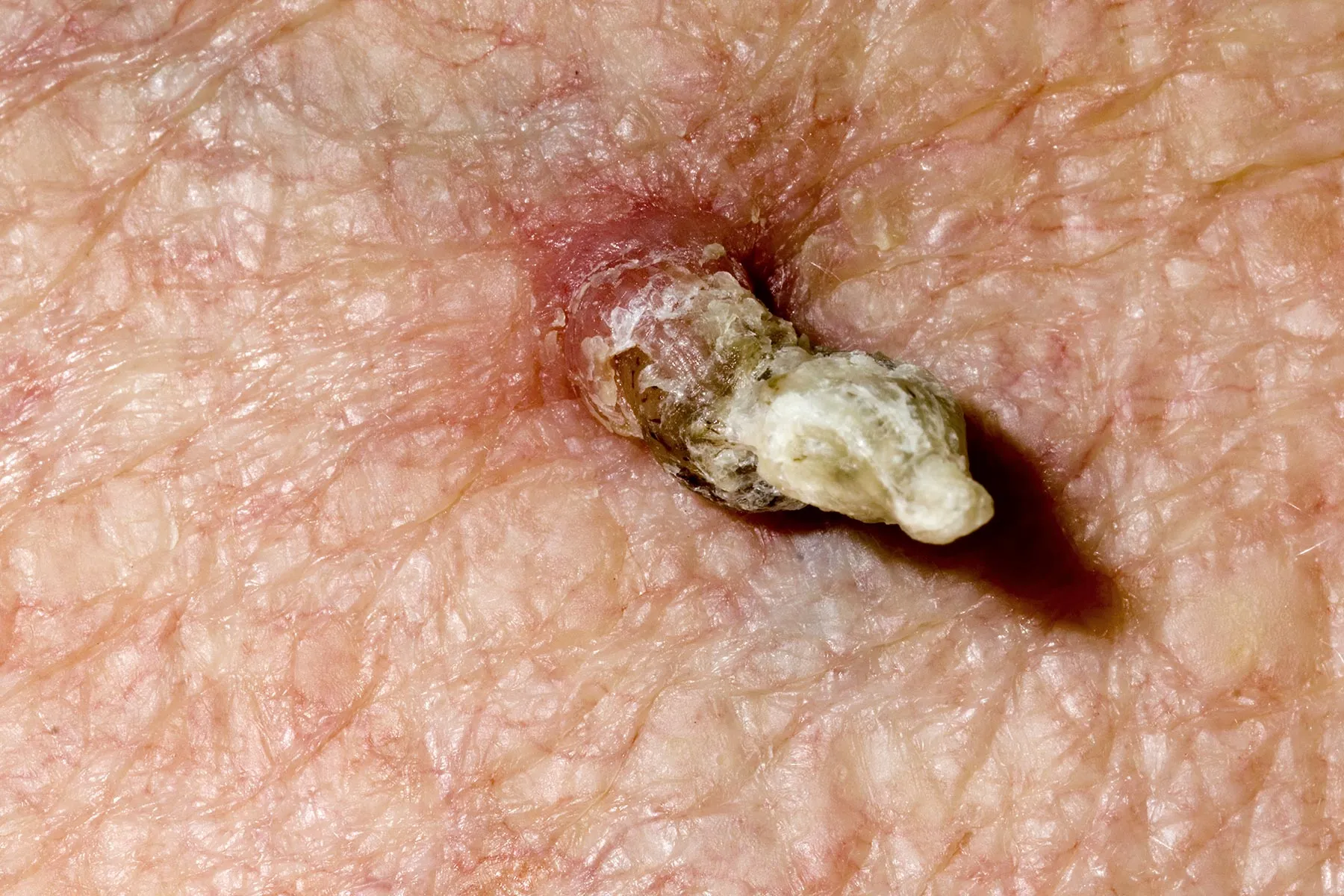Skin Problems and Treatments Medical Reference

What You Should Know About Cutaneous Horns
- What You Should Know About Phytophotodermatitis
Which rash is caused by touching certain plants and sunshine exposure?
- What Is Henna?
Henna, a hair and body dye used for body art called mehndi, is used worldwide. But it can cause skin irritation, especially if additives are used.
- Lichen Striatus
Lichen striatus is a rash that appears in children. Its smooth or scaly flat-topped bumps can be pink, tan, or flesh-colored and usually form a line or band on the skin.
- Warts: Treatments and Home Remedies
WebMD explains traditional treatments and home remedies for warts.
- Hidradenitis Suppurativa: Who Gets It?
Experts don’t completely understand what causes hidradenitis suppurativa, but they know who’s more likely to get it. Learn the risk factors.
- Don’t Ignore the Symptoms of Hidradenitis Suppurativa
You don't have to suffer through the symptoms of HS. Dermatologists can create a treatment plan to ease symptoms and help you live well.
- Hidradenitis Suppurativa and Other Causes of Boils
Boils are common and have several possible causes, including hidradenitis suppurativa.
- What to Know About Unusual Growths on Your Skin (Skin Neoplasms)
Find out what you need to know about skin neoplasms, and discover what causes them, how they're treated, and how they may affect health.
- What Is Artificial Skin?
Experts continue to work on artificial skin options that can protect and detect things just like human skin. Learn more here.
- What to Know About Smiley Piercings
Find out what you need to know about smiley piercing placement, jewelry, risks, and more.
- Elastin: What to Know
Find out what you need to know about elastin. Discover the pros, cons, risks, benefits, and how it may affect your health.
- What Is FUPA?
Learn about FUPA and problems related to fatty upper pubic areas. Discover the symptoms and the best treatments for these weight-related issues.
- Keloid Scars: Causes and Treatments
Keloid scars are thick irregular-looking scars. Learn about treatments that might improve the appearance of keloid scars.
- Prurigo Nodularis
It’s a rare but dramatic skin problem with a relentless itch and hard lumps all over your body. Learn about prurigo nodularis and how to get relief.
- Familial Cold Autoinflammatory Syndrome (FCAS)
FCAS is a rare genetic disorder. It affects how your body controls inflammation. Symptoms are triggered by exposure to the cold, though experts aren’t sure why. It’s the mildest type of cryopyrin-associated periodic syndrome (CAPS).
- Integumentary System: What to Know
Find out what you need to know about the integumentary system and discover how it may affect your health.
- Epithelium: What to Know
Find out what you need to know about the epithelium, including where epithelial cells are located in your body and how they affect your health.
- What Is Perichondritis?
Have you been diagnosed with perichondritis? Read our guide to learn more about this ear infection and how to treat it.
- What Is Calciphylaxis?
Calciphylaxis occurs when calcium builds up in your blood vessels. Learn more about what causes it, symptoms of calciphylaxis, and more.
- What to Know About a Chlorine Rash?
Some people get a rash after swimming in chlorinated pools or hot tubs. Read on to learn more about the symptoms, causes, and how to prevent chlorine rash.
- What Is a Viral Exanthem Rash?
Discover what a viral exanthem rash is. Learn how it’s caused, the symptoms, and how to treat it.
- How to Use Epsom Salt on an Ingrown Toenail
Find out how to use epsom salt on an ingrown toenail.
- Chronic Spontaneous Urticaria: Low-Histamine Diet
Could a low-histamine diet clear up chronic spontaneous urticaria, or hives? Find out which foods and drinks are higher in histamines and what to eat instead.
- What to Know About Bath Bombs and Your Skin
Bath bombs are a great way to amplify your bathtime experience but can irritate the skin. Discover how they can be used safely and avoid contracting a rash after bathing.
- What Is Myiasis?
Learn how to manage myiasis, a parasitic infection spread by fly larvae.
- What Is Cold Urticaria?
Learn what cold urticaria is, including what causes cold urticaria, cold urticaria symptoms, cold urticaria treatment, and more.
- The UV Index Explained
This tool can tell you how strong UV rays are in your area and help you protect your skin. Learn more about how it works.
- What Is Aquagenic Urticaria?
Learn what aquagenic urticaria is, as well as its causes, symptoms, treatment options, and more.
- How to Choose a Lice Comb
Discover how to choose and use a lice comb. Learn if electric, plastic, or metal combs are the best at getting rid of lice.
- What to Know about Paper Cuts
What is a paper cut, and why does it hurt so much? Find out how you get a paper cut and how you should treat it.
- Cercarial Dermatitis (Swimmer's Itch)
Learn about the parasite that causes swimmer's itch.
- What Is Solar Urticaria?
Learn about solar urticaria, a rare allergy to sun exposure.
- What to Know About Chinch Bugs
Chinch bugs are pests living in our lawns and parks. Learn more about these bugs, including their appearance, life cycle, how to treat them, and if they're dangerous to humans.
- What to Know About Sweating
Find out what you need to know about normal sweating causes, what is in sweat, and if you can sweat out toxins.
- What to Know About Oak Leaf Itch Mites
Learn more about the oak mite, what it looks like, and how to prevent their itchy bites.
- What Is an Arboviral Disease?
Arboviral diseases are transmitted to humans by insects like mosquitoes and ticks. Learn about the symptoms, treatments, and how to keep yourself safe.
- What Is Yellow Nail Syndrome?
Yellow nail syndrome is a rare disorder that affects your fingernails and toenails. Learn about the causes, symptoms, and treatment options for this condition today.
- What Is a Full-Thickness Skin Graft?
Learn about full-thickness grafts, when they're used, and when they're needed.
- What to Know About Scurvy
Learn about scurvy, including its causes, symptoms, how it's treated, and how it can be prevented.
- What to Know About Peeling Skin (Desquamation)
Peeling skin (desquamation) occurs when the top layer of your skin peels to replace itself. Learn more about what causes it, associated symptoms, and more.
- What to Know About Candidiasis Tests
Find out what you need to know about candidiasis tests and discover how invasive candidiasis is diagnosed and treated.
- What Is Eosinophilic Granuloma?
Eosinophilic granuloma is a type of benign bone lesion. Learn about the causes, symptoms, and treatment options for this condition.
- What to Know About Poliosis
Find out what you need to know about poliosis, including causes and treatments.
- What Is Chondrodermatitis?
Learn what chondrodermatitis is, how it's treated, and how you can prevent it.
- What Is the Head Lice Life Cycle?
Head lice are insects that live on human heads. Learn more about their life cycle, from nits to adults.
- What to Know About Cysts at the Base of the Spine
What are Tarlov cysts? Learn about these cysts that can develop on your spine.
- What to Know About Periungual Warts
What to know about periungual and subungual warts. How do you get them, and what are the treatments available for them.
- What Is Gianotti-Crosti Syndrome?
Learn what a Gianotti-Crosti syndrome is and what to do if your child gets it.
- What Is Erysipelas?
Learn what erysipelas is and how it is caused. Can it cause complications, or is it easily curable? Find out here.
